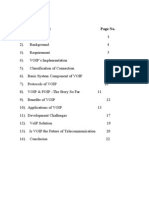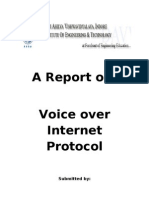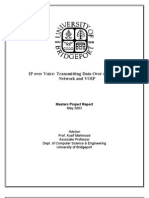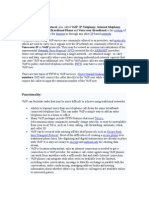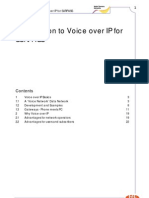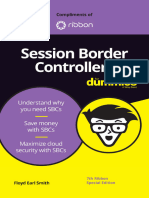Guidelines For The Implementation and Provision of Voice Over Internet Protocol (Voip) Services
Uploaded by
Peter LwandaGuidelines For The Implementation and Provision of Voice Over Internet Protocol (Voip) Services
Uploaded by
Peter LwandaGUIDELINES FOR THE IMPLEMENTATION AND PROVISION OF VOICE OVER INTERNET PROTOCOL (VOIP) SERVICES
1. Introduction Convergence in communication technologies is today leading to the development of next generation telecommunication networks that deliver audio, video and data both on wireless and wired networks. Information and communication networks are being restructured to leverage on the advantages of Internet protocol (IP) technologies. There can be no question that VoIP represents an innovative technological advancement, which confers economic advantage to users. There can equally be no doubt that VoIP allows for choice and affordability and promotes competition. In a bid to confer the advantages that this technology presents to end-users, the Commission has, through the post exclusivity regulatory strategy, adopted a technology neutral regulatory framework that will facilitate the use of IP based technologies including VoIP. The implementation of the framework will allow licensed infrastructure providers such as Internet Backbone and Gateway Operators (IBGOs), Broadcast Signal Distributors (BSDs), Commercial VSAT Operators (CVOs) and Public Data Network Operators (PDNOs), to carry any form of multimedia traffic including IP traffic e.g. VoIP. licensed application providers and in particular Internet Service Providers have been allowed to offer end-users VoIP services. This consultation document proposes guidelines on the implementation and provision of VoIP services and seeks views from network operators, service providers and users of the VoIP on the implications of the proposed guidelines. These guidelines cover the following areas:
Definition of VoIP Technical implementation of VoIP Obligations to infrastructure and application service providers
2. Definition Voice over Internet Protocol (VoIP) facilitates the conversion of analog voice signals into digital format and the transmission of such digital information in packets over networks utilizing the Internet Protocol (IP). The technology allows the transmission of voice over data networks, which may be the public Internet or private managed IP network. Voice over Internet Protocols including H323, Media Gateway Control Protocol (MGCP), Simple Gateway Control Protocol (SGCP), Session Initiation Protocol (SIP) etc allows for transmission of voice signals over data networks. IP telephony is an emerging technology that enables voice and video communication over existing IPbased Local Area Networks (LANs), Wide Area Networks (WANs) and the Internet. VoIP shall be defined as the transmission of voice over IP based networks. 3. Technical implementation Advances in technology allow telephone calls to be delivered through the public Internet and over IP enabled networks. The Commission encourages network operators to deploy IP-based networks to deliver affordable and innovative services to end-users. The deployment of this technology is expected to confer benefits to operators
including optimization of the public switched telephone network (PSTN) and transmission infrastructure, reduction of network costs, increased network redundancy and resilience and facilitation of support and flexibility in the provision of innovative and next generation services. A situational analysis of the use of VoIP services reveals the following modes of service provision and implementation: 3.1. PC to PC The VoIP communication is established by individual users who make Internet call from one computer to another. This form of communication comes at no additional cost to the users other than the Internet connectivity and access charges. Since the service is not for commercial purpose, no regulatory requirements will be needed for this self-provided or Do-it-yourself (DIY) VoIP classification. 3.2. PC/IP Phone to PSTN Due to the limitations associated with availability of PCs and Internet connectivity and the high cost of international calls delivered over legacy TDM switched networks, telephone calls are originated from PCs or IP phones and terminated on the PSTN. The only significant cost for these calls (usually long distance and International calls) is the local call charge applied by the terminating PSTN operator. In this classification the caller would originate a call from a PC or an IP telephone by dialing a complete traditional E.164 number that would be terminated on PSTN over the public Internet. The network architecture of the IP to PSTN topology is controlled by VoIP gateways that define and route the call to the terminating gateway. On the remote end, the terminating VoIP gateway connects to the local PSTN network. SIP, H.323 and MGCP VoIP protocols have been developed to support VoIP and have been utilized to interconnect the IP network to the PSTN. The provision of this class of VoIP service shall be by licensed Internet Service Providers (ISPs) and infrastructure providers as carriers. . 3.3. IP Phone to IP Phone IP network architecture differs from the traditional TDM Switched network as the underlying Internet Infrastructure consists of a dumb core network and Intelligent Customer Premise Equipments (CPEs) while the PSTN consists of an intelligent core network and dumb CPEs. The application of IP to IP phone conversations are common within Intra-corporate private networks i.e. local and wide area networks. The utilization of VoIP reduces the cost of communication in corporate communications between branch offices. In some instances, however, there may be a need to integrate remote ends to the PSTN described above as PC/IP Phone to PSTN. The utilization of this class of VoIP service shall be restricted to licensed private networks and leased networks from infrastructure providers. 3.4. PSTN via IP to PSTN Most operators are today migrating traditional circuit switching systems based on TDM technology to IP technology particularly for the provision of long distance services due to the inherent technical limitations and cost of implementation. Carriers and telecommunications operators have adapted and integrated VoIP switching for long distance communications reducing overall costs and improving quality in seamless end-to-end connection to subscribers. In this model, end-users would dial a traditional E.164 number, and the call is routed from the PSTN through a VoIP gateway over an IP network and offloaded to the PSTN and vise versa. To facilitate this arrangement fixed and mobile operators would enter into commercial bilateral and service level agreements (SLAs) for call termination to reduce call delivery costs with VoIP carriers.
VoIP carriers or operators setup VoIP Gateways and platforms to interface with local PSTN networks globally creating virtual VoIP networks for long distance calls completely transparent to end users. As a result they become carriers of telephony on the existing infrastructure. In this arrangement VoIP operators would purchase bulk voice minutes for resale within a country for example through the use of calling cards, where the end user would be required to dial a toll free or unique number to gain access to international or long distance telephony services. In this classification, VoIP providers who shall be licensed Internet Service Providers (ISP) may obtain toll free numbers from network providers to facilitate the provision of the VoIP services. . Consequently, the existing ISP licenses shall be amended as appropriate to facilitate reliable provision of this service. Existing ISPs who have complied with regulatory requirements shall be issued with the amended license upon surrender of the ISP license they are currently holding. Additionally, equipment utilized for the provision of this service and connected to the public networks shall be subject to type approval by the Commission. 3.5. PSTN to IP Phone VoIP providers have advanced the requirement to provision telephony services from traditional PSTN networks to IP Phones as opposed to just call termination to PSTN. To achieve this objective, ENUM has been developed to converge the PSTN and the IP network. ENUM enables the mapping of a traditional E.164 telephone numbers from the Public Switched Telephony Service (PSTN) to Internet services through the conversion of traditional E.164 telephone numbers to Universal Resource Locator (URL). This emerging technology provides enormous possibilities including the creation of virtual telephony operators who would be issued with E.164 telephone numbers. The Commission will initiate the process of ENUM redelegation and develop further policies and guidelines to govern this emerging technology. 4. Technical implementation classifications The Commission shall take into consideration different technical architectures for the implementation of VoIP, which shall be broadly classified as follows:
PC/IP phone to PSTN: Self- provisioning IP phone to IP phone: Intra-corporate VoIP PSTN via IP to PSTN: Carrier/operator public VoIP provisioning
The Commission is, however, cognizant of the fact that with the fast pace of convergence of voice and data, there may be no distinction of the three classes of services in the future. This classification shall, therefore, be subject to review from time to time. 5. Obligations For successful implementation of VoIP services, ISP and infrastructure providers shall be required to meet certain obligations, including:
Interconnection Universal Access Numbering and Naming Quality of Service levels Legal Interception Billing Directory Services
5.1. Interconnection Internet Service Providers being Application Service Provider (ASPs) do not own infrastructure, and shall, therefore, utilize the infrastructure of licensed network operators to provide and/or interconnect their systems to
facilitate provision of VoIP services. Network operators shall be required to provide interconnection in accordance with the Kenya Communications Regulations, 2001 5.2. Universal Access Globally VoIP is envisioned as the dominant means of the provision of voice services in the future. Consequently, to ensure equitable access to these services, both ISPs and infrastructure providers shall be subjected to universal services obligations as may be prescribed by the Commission. 5.3. Numbering and Naming In order to access end-users on either an IP address-based network or the PSTN, a global numbering/addressing scheme across both PSTN and IP address-based networks including ENUM, shall be required. VoIP providers shall, therefore, be required to comply with the Commission's numbering plan. 5.4. Quality of Service Cognizant of the fact that best effort is applied in the provision of services delivered over IP based networks, providers of VoIP service shall implement efficient routing mechanisms and appropriate pricing. End users/customers must be informed of both quality of service and pricing. In addition, the service providers shall adhere to quality of service standards as set out by the Commission from time to time.. 5.5. Legal Intercept The provision of VoIP services shall be subject to monitoring by the Commission to ensure that providers adhere to the provisions of the license, the Regulations, the Act and the laws of the country. 5.6. Billing VoIP providers shall be required to adhere to license conditions with regard to billing accuracy. 5.7. Directory Services VoIP service providers shall be required to comply with the Commission's license conditions as regards to directory services. 6. Other Conditions This consultation document does not constitute legal, commercial or technical advice and the Commission is not bound by its contents. These guidelines are subject to review by the Commission from time to time without any reference to the affected parties. DIRECTOR-GENERAL COMMUNICATIONS COMMISSION OF KENYA
Dated 10th August 2005 The Kenya Gazette Notice No 6394, 12th August 2005
You might also like
- Quality of Services . 6.security . 7.futureNo ratings yetQuality of Services . 6.security . 7.future13 pages
- Voice Over Internet Protocol (Voip) : Presentation By, V.Nithya M.Tech - IT (Final Year) 1631010033No ratings yetVoice Over Internet Protocol (Voip) : Presentation By, V.Nithya M.Tech - IT (Final Year) 163101003341 pages
- Figure 1. Digital Sampling of An Analog Voice SignalNo ratings yetFigure 1. Digital Sampling of An Analog Voice Signal23 pages
- Voice Over Internet Protocol (Voip) : A Seminar Report OnNo ratings yetVoice Over Internet Protocol (Voip) : A Seminar Report On20 pages
- Voice Over Internet Protocol (Voip) : Submitted By: Amit PrakashNo ratings yetVoice Over Internet Protocol (Voip) : Submitted By: Amit Prakash13 pages
- TechRepublic Resource Guide - Voice Over Internet Protocol (VoIP)No ratings yetTechRepublic Resource Guide - Voice Over Internet Protocol (VoIP)13 pages
- Voice Over IP: What It Is, Why People Want It, and Where It Is GoingNo ratings yetVoice Over IP: What It Is, Why People Want It, and Where It Is Going31 pages
- Voice Over Internet Protocol (VOIP) : Overview, Direction and ChallengesNo ratings yetVoice Over Internet Protocol (VOIP) : Overview, Direction and Challenges12 pages
- A Quick Introduction To Voice Over Internet Protocol (Voip)No ratings yetA Quick Introduction To Voice Over Internet Protocol (Voip)4 pages
- A Report On: Voice Over Internet Protocol: Submitted byNo ratings yetA Report On: Voice Over Internet Protocol: Submitted by9 pages
- Research Report: Bachelor of Engineering Computer Science & EnggNo ratings yetResearch Report: Bachelor of Engineering Computer Science & Engg22 pages
- Part Five Voice Over IP and Converged InfrastructureNo ratings yetPart Five Voice Over IP and Converged Infrastructure41 pages
- Introduction To Voice Over IP For SurpassNo ratings yetIntroduction To Voice Over IP For Surpass22 pages
- (Voice Over Internet Protocol) : by Samresh ChandNo ratings yet(Voice Over Internet Protocol) : by Samresh Chand15 pages
- (Introducing Voice Over Ip Networks) : Voip FundamentalsNo ratings yet(Introducing Voice Over Ip Networks) : Voip Fundamentals8 pages
- Voice Over Internet Protocol: Technical Seminar OnNo ratings yetVoice Over Internet Protocol: Technical Seminar On3 pages
- Real-Time Voice Over Packet-Switched NetworksNo ratings yetReal-Time Voice Over Packet-Switched Networks10 pages
- Advanced VoIP and IP Telephony: Telecom Titans: Building the Connected World, #4From EverandAdvanced VoIP and IP Telephony: Telecom Titans: Building the Connected World, #4No ratings yet
- Bandwidth Allocation for Video under Quality of Service ConstraintsFrom EverandBandwidth Allocation for Video under Quality of Service ConstraintsNo ratings yet
- Sandeep Ranjan Abhishek Jain Manik Gupta Vaibhav Tiwari Arpit Jain Manavi GuptaNo ratings yetSandeep Ranjan Abhishek Jain Manik Gupta Vaibhav Tiwari Arpit Jain Manavi Gupta20 pages
- 1 0 SV9100 SIP Trunk Config Guide XCast LabsNo ratings yet1 0 SV9100 SIP Trunk Config Guide XCast Labs38 pages
- Matrix Telecom ETERNITY PENX Technical SpecificationNo ratings yetMatrix Telecom ETERNITY PENX Technical Specification4 pages
- Central Office Codes and Home Network Identifier - HNI - Numbering Plan0% (1)Central Office Codes and Home Network Identifier - HNI - Numbering Plan74 pages
- Immediate download Mobile Computing Technology Applications And Service Creation 2nd Edition Hasan Et Al. Talukder ebooks 2024100% (5)Immediate download Mobile Computing Technology Applications And Service Creation 2nd Edition Hasan Et Al. Talukder ebooks 202460 pages
- A Comparative Study On Ipv4 and Ipv6: January 2015No ratings yetA Comparative Study On Ipv4 and Ipv6: January 20159 pages
- Indian Railways: Dayalbhag Educational IntituteNo ratings yetIndian Railways: Dayalbhag Educational Intitute22 pages
- FOP ConfiguringaGrandstreamGXW 410XDevicetoactasanFXOGateway 170722 0237 30740No ratings yetFOP ConfiguringaGrandstreamGXW 410XDevicetoactasanFXOGateway 170722 0237 307405 pages
- Quectel BG96: LTE Cat M1 & Cat NB1 & EGPRS ModuleNo ratings yetQuectel BG96: LTE Cat M1 & Cat NB1 & EGPRS Module2 pages
- List of Telecommunication Companies in Pakistan - WikipediaNo ratings yetList of Telecommunication Companies in Pakistan - Wikipedia4 pages
- Accelerate 2019, 4th April - AudioCodes' Solutions For Microsoft, Ran InbarNo ratings yetAccelerate 2019, 4th April - AudioCodes' Solutions For Microsoft, Ran Inbar46 pages
- Voice Over Internet Protocol (Voip) : Presentation By, V.Nithya M.Tech - IT (Final Year) 1631010033Voice Over Internet Protocol (Voip) : Presentation By, V.Nithya M.Tech - IT (Final Year) 1631010033
- Figure 1. Digital Sampling of An Analog Voice SignalFigure 1. Digital Sampling of An Analog Voice Signal
- Voice Over Internet Protocol (Voip) : A Seminar Report OnVoice Over Internet Protocol (Voip) : A Seminar Report On
- Voice Over Internet Protocol (Voip) : Submitted By: Amit PrakashVoice Over Internet Protocol (Voip) : Submitted By: Amit Prakash
- TechRepublic Resource Guide - Voice Over Internet Protocol (VoIP)TechRepublic Resource Guide - Voice Over Internet Protocol (VoIP)
- Voice Over IP: What It Is, Why People Want It, and Where It Is GoingVoice Over IP: What It Is, Why People Want It, and Where It Is Going
- Voice Over Internet Protocol (VOIP) : Overview, Direction and ChallengesVoice Over Internet Protocol (VOIP) : Overview, Direction and Challenges
- A Quick Introduction To Voice Over Internet Protocol (Voip)A Quick Introduction To Voice Over Internet Protocol (Voip)
- A Report On: Voice Over Internet Protocol: Submitted byA Report On: Voice Over Internet Protocol: Submitted by
- Research Report: Bachelor of Engineering Computer Science & EnggResearch Report: Bachelor of Engineering Computer Science & Engg
- Part Five Voice Over IP and Converged InfrastructurePart Five Voice Over IP and Converged Infrastructure
- (Introducing Voice Over Ip Networks) : Voip Fundamentals(Introducing Voice Over Ip Networks) : Voip Fundamentals
- Voice Over Internet Protocol: Technical Seminar OnVoice Over Internet Protocol: Technical Seminar On
- Advanced VoIP and IP Telephony: Telecom Titans: Building the Connected World, #4From EverandAdvanced VoIP and IP Telephony: Telecom Titans: Building the Connected World, #4
- Bandwidth Allocation for Video under Quality of Service ConstraintsFrom EverandBandwidth Allocation for Video under Quality of Service Constraints
- Sandeep Ranjan Abhishek Jain Manik Gupta Vaibhav Tiwari Arpit Jain Manavi GuptaSandeep Ranjan Abhishek Jain Manik Gupta Vaibhav Tiwari Arpit Jain Manavi Gupta
- Matrix Telecom ETERNITY PENX Technical SpecificationMatrix Telecom ETERNITY PENX Technical Specification
- Central Office Codes and Home Network Identifier - HNI - Numbering PlanCentral Office Codes and Home Network Identifier - HNI - Numbering Plan
- Immediate download Mobile Computing Technology Applications And Service Creation 2nd Edition Hasan Et Al. Talukder ebooks 2024Immediate download Mobile Computing Technology Applications And Service Creation 2nd Edition Hasan Et Al. Talukder ebooks 2024
- A Comparative Study On Ipv4 and Ipv6: January 2015A Comparative Study On Ipv4 and Ipv6: January 2015
- FOP ConfiguringaGrandstreamGXW 410XDevicetoactasanFXOGateway 170722 0237 30740FOP ConfiguringaGrandstreamGXW 410XDevicetoactasanFXOGateway 170722 0237 30740
- List of Telecommunication Companies in Pakistan - WikipediaList of Telecommunication Companies in Pakistan - Wikipedia
- Accelerate 2019, 4th April - AudioCodes' Solutions For Microsoft, Ran InbarAccelerate 2019, 4th April - AudioCodes' Solutions For Microsoft, Ran Inbar


























